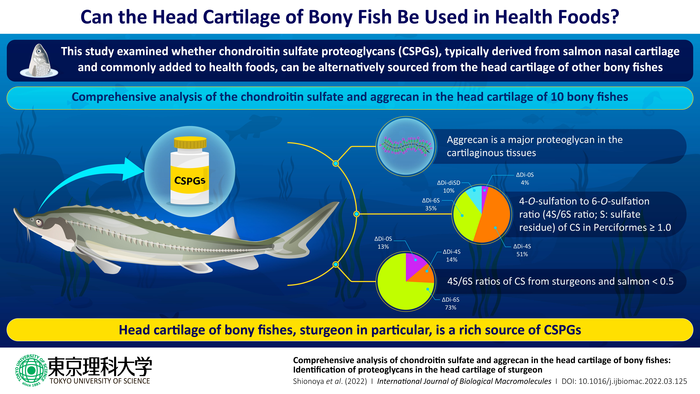Aggrecan, a major component of proteoglycan (PG) having chondroitin sulfate (CS) in cartilaginous tissues, has become increasingly popular as an ingredient in health food. In fact, proteoglycans from salmon nasal cartilage demonstrate biological properties such as antiaging, inhibition of angiogenesis, and attenuation of inflammatory responses. Commercially available chondroitin sulfate proteoglycans (CSPGs) have only been prepared from salmon nasal cartilage. Although the head cartilage was found in other edible bony fishes, there is little information on the composition of core proteins and their CS structures in the head cartilage.

Credit: TOKYO UNIVERSITY OF SCIENCE
Aggrecan, a major component of proteoglycan (PG) having chondroitin sulfate (CS) in cartilaginous tissues, has become increasingly popular as an ingredient in health food. In fact, proteoglycans from salmon nasal cartilage demonstrate biological properties such as antiaging, inhibition of angiogenesis, and attenuation of inflammatory responses. Commercially available chondroitin sulfate proteoglycans (CSPGs) have only been prepared from salmon nasal cartilage. Although the head cartilage was found in other edible bony fishes, there is little information on the composition of core proteins and their CS structures in the head cartilage.
Now, in a new study published in the International Journal of Biology Macromolecules, a team of researchers led by Associate Professor Kyohei Higashi of Tokyo University of Science, and Dr. Naoshi Dohmae and Dr. Takehiro Suzuki of the RIKEN Center for Sustainable Resource Science tackles this question. “We found that composition of PGs and their CS structure in the skull of the Siberian sturgeon and Russian sturgeon were similar to that in the salmon nasal cartilage,” reports Dr. Higashi. The fishes for the study were provided by Mr. Atsuhi Nakamura from Miyazaki Prefectural Fisheries Research Institute. This study was made available online on March 23, 2022 and was published in Volume 208 of the journal on May 31, 2022.
All the fishes examined contained abundant CSPGs in the head cartilage. Comprehensive analysis of CS structure in PGs derived from 10 bony fishes revealed that the structure of CS derived from Perciformes were similar to that of CS derived from cartilage of terrestrial animals. On the other hand, the structure of CS from skull of sturgeons was similar to that of CS from salmon nasal cartilage. In addition, they also found that aggrecan, a major CSPG in the cartilaginous tissue, was conserved in 10 bony fishes. In fact, the aggrecan protein from LOC117428125 and LOC117964296 genes registered in the National Center for Biotechnology Information database was found to be abundant in the skull of sturgeons. Furthermore, compositions of other PGs, collagens, and matrix proteins in the skull of sturgeons were similar to that of salmon nasal cartilage.
Elaborating on the findings of this study, Dr. Kyohei Higashi says, “Head cartilage from bony fishes is an underutilized resource and is typically discarded after food processing. The PGs, especially from the sturgeon, are similar in CS structure to the salmon nasal cartilage, showing that the sturgeon has a lot of potential to be an alternative source of CSPGs for health food formulations.”
The researchers hope with further studies to evaluate the biological properties of sturgeon PG, bony fishes could become an important source for CS as well as PGs.
***
Reference
DOI: https://doi.org/10.1016/j.ijbiomac.2022.03.125
About The Tokyo University of Science
Tokyo University of Science (TUS) is a well-known and respected university, and the largest science-specialized private research university in Japan, with four campuses in central Tokyo and its suburbs and in Hokkaido. Established in 1881, the university has continually contributed to Japan’s development in science through inculcating the love for science in researchers, technicians, and educators.
With a mission of “Creating science and technology for the harmonious development of nature, human beings, and society”, TUS has undertaken a wide range of research from basic to applied science. TUS has embraced a multidisciplinary approach to research and undertaken intensive study in some of today’s most vital fields. TUS is a meritocracy where the best in science is recognized and nurtured. It is the only private university in Japan that has produced a Nobel Prize winner and the only private university in Asia to produce Nobel Prize winners within the natural sciences field.
Website: https://www.tus.ac.jp/en/mediarelations/
About Dr. Kyohei Higashi from Tokyo University of Science
Dr. Kyohei Higashi is an Associate Professor in the Department of Pharmacy at Tokyo University of Science, Japan. He has analyzed the structure of glycosaminoglycans in biological samples to understand the physiological function of proteoglycans, glycosaminoglycans, and the mechanism of onset of inflammation.
Journal
International Journal of Biological Macromolecules
DOI
10.1016/j.ijbiomac.2022.03.125
Method of Research
Experimental study
Subject of Research
Animals
Article Title
Comprehensive analysis of chondroitin sulfate and aggrecan in the head cartilage of bony fishes: Identification of proteoglycans in the head cartilage of sturgeon
Article Publication Date
31-May-2022
COI Statement
None.




